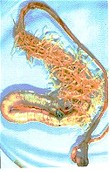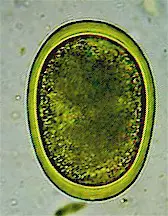Ascaridia is a genus of parasitic roundworms  belonging to the ascarids that infects chickens, turkeys, ducks, geese, grouse, quails, pheasants, guinea fowls and other domestic and wild birds.
belonging to the ascarids that infects chickens, turkeys, ducks, geese, grouse, quails, pheasants, guinea fowls and other domestic and wild birds.
They occur worldwide and are very common in chicken. Several studies report incidences of up to 90% in various countries. It is much more abundant in traditional farming with outdoor run than in industrial production facilities.
These worms do not affect dogs, cats, cattle sheep, goats, horses or swine.
The most relevant species for domestic birds are:
- Ascaridia galli infects mainly chicken, but also turkey, geese, guinea fowls, etc.
- Ascaridia dissimilis infects mainly turkey.
- Ascaridia columbae infects mainly pigeons in Africa.
Other ascarids of veterinary importance are Ascaris suum in swine, Toxocara vitulorum in cattle, Toxocara canis in dogs, and Toxocara cati in cats.
The disease caused by Ascaridia worms is called ascaridiasis..
Are birds infected with Ascaridia worms contagious for humans?
- NO: The reason is that these worms are not human parasites.
You can find additional information in this site on the general biology of parasitic worms and/or roundworms.
Final location of Ascaridia worms
Predilection site of adult Ascaridia worms is the small intestine. Adult worms may occasionally reach the cloaca (and be found in the feces) and the oviduct (and infect the hens' eggs).
Anatomy of Ascaridia worms

Adult Ascaridia worms are they largest roundworms found in domestic birds. They are up to 12 cm long and of a whitish color, rather transparent. Females are longer than males.
As in other roundworms, the body of these worms is covered with a cuticle, which is flexible but rather tough. The worms have a tubular digestive system with two openings. They also have a nervous system but no excretory organs and no circulatory system, i.e. neither a heart nor blood vessels.
The female ovaries are large and the uteri end in an opening, which in these worms is located close to the middle of the body. Males have a sucker close to the anus and a copulatory bursa with two equal spicules for attaching to the female during copulation.
Ascaridia eggs are ovoid, about 50x80 micrometers, with a thick and smooth shell.
Life cycle of Ascaridia worms
Ascaridia worms have direct life cycle. Adult female worms in the small intestine pass eggs with the feces. Once in the environment infective larvae develop inside the eggs in about 12 days by 33°C, but usually slower but lower temperatures. Such eggs can remain infective in the birds' litter for one year and longer. They do not develop at temperatures below 12°C, but may survive slight frost. Earthworms can ingest large amounts of infective eggs and act as mechanical vectors.
Birds become infected after eating infective eggs, either directly with contaminated food or water, or indirectly through infected earthworms. Ingested eggs release the larvae in the gut's lumen where they molt and remain for about 10 days. Subsequently they penetrate into the gut's lining where they spend 1 to 7 weeks and molt again. Afterwards they return to the gut's lumen where they complete development to adult worms and the females start producing eggs.
The prepatent period (time between infection and first eggs shed) is 6 to 8 weeks, depending on the worm species and the host.
Harm caused by Ascaridia worms, symptoms and diagnosis
Larvae in the gut's lining are the most damaging stage. They destroy the tissues around them. This causes enteritis (inflammation of the intestine), often hemorrhagic. Clinical signs include loss of weight and appetite, unthriftiness, pale combs and wattles, droopy wings, wasting, diarrhea and anemia.
Mortality can be high (up to 30%) in case of heavy infections. Adult worms are also harmful. They compete for nutrients, can cause mechanical damage of the gut's wall, and may obstruct the intestine.
Ascaridia infections are especially harmful for young chicken up to 3 months old, especially if they suffer from vitamin or protein deficiency. Development is significantly retarded and mortality can be higher than 35%. Weight gains in broilers and egg production in layers and can be reduced by more than 30%.
Egg quality can also be impaired (e.g. pale egg yolk). Older birds become progressively resistant, which reduces both the harm and the reproduction of the worms, i.e. the contamination of their environment with eggs. Resistant is breed-dependent.
Diagnosis is based on detection of typical eggs in the feces and/or on identification of the worms after necropsy.
Prevention and control of Ascaridia
To prevent or at least reduce Ascaridia infections it is recommended to keep the birds' bedding as dry as possible and to frequently change it, because development of the worm's eggs needs humidity. Strict hygiene of feeders and drinkers are a must to avoid or reduce their contamination with eggs. Pasture rotation is also recommended.
All these measures are particularly important for young birds. For birds kept outdoors it is advisable to restrict their access to humid environments where earthworms are usually more abundant.
Numerous classic broad spectrum anthelmintics are effective against Ascaridia worms, e.g. several benzimidazoles (albendazole, fenbendazole, flubendazole, mebendazole, oxfendazole, etc.), levamisole, as well as macrocyclic lactones (e.g. ivermectin). Some compounds with a narrower spectrum are also effective against these worms, e.g. piperazine derivatives and pyrantel.
For use on poultry these active ingredients are usually available as additives for feed or drinking water, seldom as injectables or tablets (mainly for single animal treatment, typical for fighting roosters).
Most such wormers (e.g. benzimidazoles, levamisole, piperazine derivatives and pyrantel) kill the worms shortly after treatment and are quickly metabolized and/or excreted within a few hours or days. This means that they have a short residual effect, or no residual effect at all. As a consequence treated animals are cured from worms but do not remain protected against new infections. To ensure that they remain worm-free the animals have to be dewormed periodically, depending on the local epidemiological, ecological and climatic conditions.
So far no vaccine is available against Ascaridia worms. To learn more about vaccines against parasites of livestock and pets click here.
Biological control of Ascaridia worms (i.e. using its natural enemies) is so far not feasible.
You may be interested in an article in this site on medicinal plants against external and internal parasites.
Resistance of Ascaridia worms to anthelmintics
There are a no reports on confirmed resistance of Ascaridia worms to anthelmintics.
This means that if an anthelmintic fails to achieve the expected efficacy against Ascaridia worms it is most likely that either the product was unsuited for the control of these worms, or it was used incorrectly.
|
Ask your veterinary doctor! If available, follow more specific national or regional recommendations for Ascaridia control. |